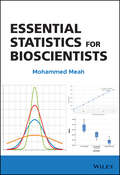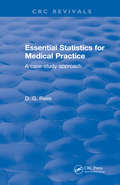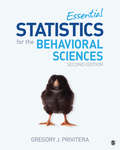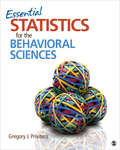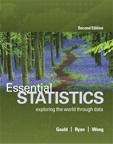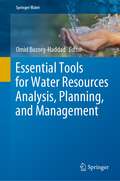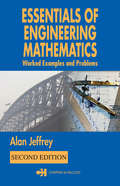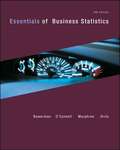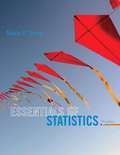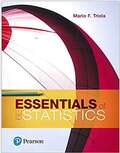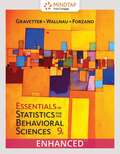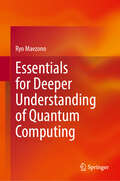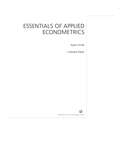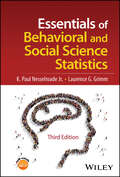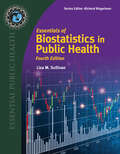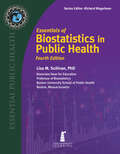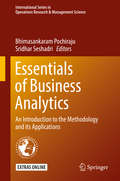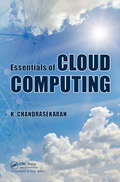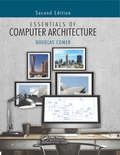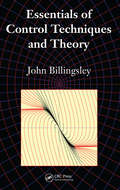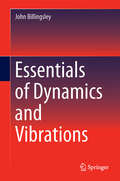- Table View
- List View
Essential Statistics
by William Cyrus NavidiThis book is designed for an introductory course in statistics. The mathematical prerequisite is basic algebra. In addition to presenting the mechanics of the subject, we have endeavored to explain the concepts behind them, in a writing style as straightforward, clear, and engaging as we could make it.
Essential Statistics for Bioscientists
by Mohammed MeahDive into the most common statistical tests and software packages used for scientific data analysis and interpretation In Essential Statistics For Bioscientists, experienced university and bioscientist Dr Mohammed Meah delivers easy access to statistical analysis and data presentation. It is a great resource for students in the field of life and health sciences to conceptualize, analyze, and present data. This book uses three popular and commonly used statistics softwares—Microsoft Excel, Graphpad Prism, and SPSS—and offers clear, step-by-step instructions for essential data analysis and graphical/tabular display of data. Beginning with fundamental statistics terminology and concepts, including data types, descriptive statistics (central and spread of data), exploratory statistics (graphical display) and inferential statistics (hypothesis testing and correlation), the content gradually builds in complexity, explaining which statistical test is best suited and how to perform it. A thorough introduction to basic statistical terms and building up to an advanced level of statistical application- ideal for those new to study of statistics Extensive application of three popular software packages- Microsoft Excel, Graphpad Prism and SPSS Numerous hands-on examples of performing data analysis using Microsoft Excel, Graphpad Prism, and SPSS Considers the limitations and errors of statistical analysis Essential reading for those designing and planning a research project in Biosciences Perfect for undergraduate students in the life and health sciences, Essential Statistics For Bioscientists will also earn a place in the libraries of anyone studying medicine, nursing, physiotherapy, pharmacy, and dentistry requiring a refresher or primer on statistical fundamentals.
Essential Statistics for Medical Practice
by D.G. ReesA firm understanding of the basic statistical methods used in current medical literature is now essential for medical practice, as research papers have become increasingly statistical in nature. This book has a unique, case-study approach, starting with six actual research papers showing which statistical methods were used and how the results were obtained. It will enable the medical professional to understand the methods in an easy and accessible way.
Essential Statistics for the Behavioral Sciences
by Gregory J. PriviteraEssentials of Statistics for the Behavioral Sciences is a concise version of Statistics for the Behavioral Sciences by award-winning teacher, author, and advisor Gregory J. Privitera. The Second Edition provides balanced coverage for today’s students, connecting the relevance of core concepts to daily life with new introductory vignettes for every chapter, while speaking to the reader as a researcher when covering statistical theory, computation, and application. Robust pedagogy allows students to continually check their comprehension and hone their skills while working through carefully developed problems and exercises that include current research and seamless integration of IBM® SPSS® Statistics. Readers will welcome Privitera’s thoughtful instruction, conversational voice, and application of statistics to real-world problems. A Complete Teaching & Learning Package. SAGE coursepacks FREE! SAGE coursepacks makes it easy to import our quality instructor and student resource content into your school’s learning management system (LMS). Intuitive and simple to use, SAGE coursepacks allows you to customize course content to meet your students’ needs. . SAGE edge FREE! SAGE edge offers both instructors and students a robust online environment with an impressive array of teaching and learning resources. Study Guide With IBM® SPSS® Workbook Bundle the Second Edition with the accompanying Student Study Guide With IBM® SPSS® Workbook for Essential Statistics for the Behavioral Sciences. Guide for Users of R, SAS®, and Stata® Bundle the Second Edition with the accompanying Essentials of Statistical Analysis "In Focus". WebAssign® This title is available on WebAssign, allowing instructors to produce and manage assignments with their students online using a grade book that allows them to track and monitor students′ progress. Students receive unlimited practice using a combination of multiple choice and algorithmic questions, and are allowed unlimited access to this edition of the textbook in the same course at no additional cost. WebAssign provides instant feedback and links directly to the accompanying eBook section where the concept was covered, allowing students to find the correct solution.
Essential Statistics for the Behavioral Sciences
by Gregory J. PriviteraEssentials of Statistics for the Behavioral Sciences is a concise version of Statistics for the Behavioral Sciences by award-winning teacher, author, and advisor Gregory J. Privitera. The Second Edition provides balanced coverage for today’s students, connecting the relevance of core concepts to daily life with new introductory vignettes for every chapter, while speaking to the reader as a researcher when covering statistical theory, computation, and application. Robust pedagogy allows students to continually check their comprehension and hone their skills while working through carefully developed problems and exercises that include current research and seamless integration of IBM® SPSS® Statistics. Readers will welcome Privitera’s thoughtful instruction, conversational voice, and application of statistics to real-world problems. A Complete Teaching & Learning Package. SAGE coursepacks FREE! SAGE coursepacks makes it easy to import our quality instructor and student resource content into your school’s learning management system (LMS). Intuitive and simple to use, SAGE coursepacks allows you to customize course content to meet your students’ needs. . SAGE edge FREE! SAGE edge offers both instructors and students a robust online environment with an impressive array of teaching and learning resources. Study Guide With IBM® SPSS® Workbook Bundle the Second Edition with the accompanying Student Study Guide With IBM® SPSS® Workbook for Essential Statistics for the Behavioral Sciences. Guide for Users of R, SAS®, and Stata® Bundle the Second Edition with the accompanying Essentials of Statistical Analysis "In Focus". WebAssign® This title is available on WebAssign, allowing instructors to produce and manage assignments with their students online using a grade book that allows them to track and monitor students′ progress. Students receive unlimited practice using a combination of multiple choice and algorithmic questions, and are allowed unlimited access to this edition of the textbook in the same course at no additional cost. WebAssign provides instant feedback and links directly to the accompanying eBook section where the concept was covered, allowing students to find the correct solution.
Essential Statistics for the Behavioral Sciences: Alternate Guides For R, Sas, And Stata For Essential Statistics For The Behavioral Sciences
by Dr Gregory J. PriviteraEmploying the hallmark pedagogical support of his successful comprehensive text, award-winning author, teacher, and advisor Gregory J. Privitera offers a brief and engaging introduction to the field with Essential Statistics for the Behavioral Sciences. Practical examples, integrated SPSS® coverage and screenshots, and numerous learning tools make intimidating concepts accessible. Students will welcome Privitera's clear instruction, conversational voice, and application of statistics to current, real-life research problems.
Essential Statistics for the Behavioral Sciences: Alternate Guides For R, Sas, And Stata For Essential Statistics For The Behavioral Sciences
by Dr Gregory J. PriviteraEmploying the hallmark pedagogical support of his successful comprehensive text, award-winning author, teacher, and advisor Gregory J. Privitera offers a brief and engaging introduction to the field with Essential Statistics for the Behavioral Sciences. Practical examples, integrated SPSS® coverage and screenshots, and numerous learning tools make intimidating concepts accessible. Students will welcome Privitera's clear instruction, conversational voice, and application of statistics to current, real-life research problems.
Essential Statistics: Exploring the World through Data (Second Edition)
by Robert Gould Rebecca Wong Colleen RyanWe live in a data-driven world, and the goal of this text is to teach students how to access and analyze these data critically. Authors Rob Gould, Colleen Ryan, and Rebecca Wong want students to develop a "data habit of mind" because learning statistics is an essential life skill that extends beyond the classroom.and Regardless of their math backgrounds, students will learn how to think about data and how to reason using data. With a clear, unintimidating writing style and carefully chosen pedagogy, this text makes data analysis accessible to all students.
Essential Tools for Water Resources Analysis, Planning, and Management (Springer Water)
by Omid Bozorg-HaddadThis book describes concepts and tools needed for water resources management, including methods for modeling, simulation, optimization, big data analysis, data mining, remote sensing, geographical information system, game theory, conflict resolution, System dynamics, agent-based models, multiobjective, multicriteria, and multiattribute decision making and risk and uncertainty analysis, for better and sustainable management of water resources and consumption, thus mitigating the present and future global water shortage crisis. It presents the applications of these tools through case studies which demonstrate its benefits of proper management of water resources systems. This book acts as a reference for students, professors, industrial practitioners, and stakeholders in the field of water resources and hydrology.
Essentials Engineering Mathematics
by Alan JeffreyFirst published in 1992, Essentials of Engineering Mathematics is a widely popular reference ideal for self-study, review, and fast answers to specific questions. While retaining the style and content that made the first edition so successful, the second edition provides even more examples, new material, and most importantly, an introduction to usi
Essentials Of Business Statistics
by Bruce L. Bowerman Richard O'Connell J. Burdeane OrrisThe new edition of Essentials of Business Statistics delivers clear and understandable explanations of core business statistics concepts, making it ideal for a one-term course in business statistics. The author team--Bowerman/O'Connell/Murphree/Orris-emphasize the importance of interpreting statistical results to make effective decisions to improve business processes. The text offers real applications of statistics that are relevant to today's business students which can be seen in the continuing case studies throughout the book. Continuing cases span throughout a chapter or even groups of chapters, easing students into new topic areas. Connect is the only integrated learning system that empowers students by continuously adapting to deliver precisely what they need, when they need it, and how they need it, so that your class time is more engaging and effective.
Essentials Of Statistics
by Mario F. TriolaFrom SAT scores to job search methods, statistics influences and shapes the world around us. Marty Triola's text continues to be the bestseller because it helps students understand the relationship between statistics and the world, bringing life to the theory and methods. Essentials of Statistics raises the bar with every edition by incorporating an unprecedented amount of real and interesting data that will help instructors connect with students today, and help them connect statistics to their daily lives. The Fifth Edition contains more than 1,800 exercises, 89% of which use real data and 85% of which are new. Hundreds of examples are included, 91% of which use real data and 84% of which are new. New coverage of Ethics in Statistics highlights new guidelines that have been established in the industry.
Essentials Of Statistics
by Mario TriolaFor courses in Introductory Statistics. <P><P> Real data bring statistics to life From opinion polls and clinical trials to self-driving cars, statistics influences and shapes the world around us. Best-selling author Marty Triola is committed to keeping Essentials of Statistics current ― with an unprecedented amount of current real data ― so that students of all majors understand the role of statistics in the world around them. In addition to an abundance of new data sets, examples, and exercises, the 6th Edition is even more effective for today’s instructors with the addition of learning objectives as an organizational tool, larger data sets, and new topics and organization in line with advancements in statistics education. In addition, students will find more support in an all-new series of videos, additional opportunities for practice, and improved support for statistical software. Essentials of Statistics is part of a series that includes Elementary Statistics, Elementary Statistics Using the TI 83/84 Plus Calculator, andElementary Statistics Using Excel. Data sets and other resources for this series are available at our website.
Essentials Of Statistics For Business And Economics
by David R. Anderson Dennis J. Sweeney Thomas A. Williams Jeffrey D. Camm James J. CochranThis text is the eighth edition of ESSENTIALS OF STATISTICS FOR BUSINESS AND ECONOMICS. Current users of the seventh edition will notice that the chapters offered and topics covered in this edition differ from previous editions. While the topical coverage of the first nine chapters remains the same, the organization and coverage in some of the later chapters, as well as the number of chapters, have expanded.
Essentials Of Statistics For The Behavioral Sciences
by Frederick Gravetter Larry Wallnau Lori-Ann ForzanoA brief version of Gravetter and Wallnau's proven bestseller, ESSENTIALS OF STATISTICS FOR THE BEHAVIORAL SCIENCES, 9th Edition delivers straightforward instruction, unrivaled accuracy, built-in learning aids, and a wealth of real-world examples and illustrations. The authors take time to explain statistical procedures so that students can go beyond memorizing formulas and begin gaining a conceptual understanding of statistics. By skillfully integrating applications that reinforce concepts, they ensure that even students with a weak background in mathematics can fully understand statistics. <p><p> The text also leads readers to become savvy consumers of information by showing how having an understanding of statistical procedures will help them comprehend published findings. This edition features a new focus on learning objectives, which provide a structure for organizing lectures and preparing assignments and exams.
Essentials for Deeper Understanding of Quantum Computing
by Ryo MaezonoThis textbook provides a self-contained basic tutorial to help readers confidently understand and comprehend the fundamental element of quantum computing, that is, the "quantum state (spin) represented by the Bloch sphere." The primary target audience includes readers from information technology or business fields who are entering the quantum computing domain without prior experience in physics courses. Additionally, the content is designed to be a valuable refresher for those already familiar with physics or those teaching quantum physics. This volume overcomes the difficulties of existing quantum computing tutorials by providing a solution that demonstrates how, given a semester's worth of time, readers with a high school level of mathematics can be introduced to the concept of spinors without any top-down explanations. Avoiding top-down explanations entirely, the book explains the necessary minimum mathematics and physics in a logically natural progression to help readers understand why we think in such ways. The focus is on understanding the interrelationships between theories—what knowledge is needed to understand what concepts. Everything extraneous to understanding the logical flow has been meticulously removed. The goal is to efficiently bring readers to a level where they can approach quantum computing without any background knowledge anxieties.
Essentials of Applied Econometrics
by J. Edward Taylor Aaron D. SmithEssentials of Applied Econometrics prepares students for a world in which more data surround us every day and in which econometric tools are put to diverse uses. Written for students in economics and for professionals interested in continuing an education in econometrics, this succinct text not only teaches best practices and state-of-the-art techniques, but uses vivid examples and data obtained from a variety of real world sources. The book's emphasis on application uniquely prepares the reader for today's econometric work, which can include analyzing causal relationships or correlations in big data to obtain useful insights.
Essentials of Behavioral and Social Science Statistics
by Laurence G. Grimm K. Paul Nesselroade Jr.Comprehensive resource on applying statistical analyses to behavioral and social science research situations, with new examples, methods, and support for computing in Excel and SPSS The Third Edition of Essentials of Behavioral and Social Science Statistics prompts the student to develop a deep understanding of the psychometric principles involved in the research process, as well as a mastery of the particular functionality of the most common statistical tools and an ability to properly select and use them in the real world; this goal is achieved thanks to the organization of the text, the philosophical content interspersed within it, the depth of the exercises and work problems, and the supporting materials provided for the instructor and student. The Third Edition has been thoroughly edited and streamlined to allow for students to move efficiently through the conceptual and mathematical fundamentals and on to the payoff formulas and descriptions of applications. New content includes philosophical issues associated with psychometrics and inferential statistical testing, interpretation, measurement, and the replication crisis in the social sciences. End-of-chapter exercises and work problems have been strengthened and reorganized to further improve comprehension and performance. Section reviews that draw on concepts from all preceding chapters are included to help students develop skills of statistical tool selection and application. Support for instructors includes chapter-based learning objectives, test banks, and PowerPoints. Essentials of Behavioral and Social Science Statistics includes information on: Basic concepts in research covering the scientific method, types of variables, controlling extraneous variables, validity issues, and causality and correlationDescriptive statistics including scales of measurement, measures of central tendency and variability, transformations, and standardized scoresThe fundamentals of inferential statistics, including probability theory, sampling distributions, the central limit theorem, and the terminology of hypothesis testingThe logic and application of basic inferential tests including single-sample tests, independent-and dependent-samples t tests, and the basics of power analysisThe logic and application of three common ANOVA analyses; one-way, two-way, and repeated-measuresThe logic and application of basic bivariate data analysis tools, linear correlation and linear regressionThe logic and application of chi-square analyses, both goodness-of-fit and tests-for-independence Written to facilitate concept mastery and enable practical application of concepts, Essentials of Behavioral and Social Science Statistics offers a survey of basic descriptive and inferential statistical tools and concepts and is highly suitable to support a rigorous undergraduate behavioral science or social science statistics course.
Essentials of Biostatistics for Public Health
by Lisa M. SullivanEssentials of Biostatistics in Public Health, Fourth Edition provides a fundamental and engaging background for students learning to apply and appropriately interpret biostatistics applications in the field of public health. Many examples are drawn directly from the author’s remarkable clinical experiences with the renowned Framingham Heart Study, making this text practical, interesting, and accessible for those with little mathematical background. The examples are real, relevant, and manageable in size so that students can easily focus on applications rather than become overwhelmed by computations. The Fourth Edition has been thoroughly updated, and now offers a new chapter on career opportunities and new case studies in each chapter focused on COVID-19. This edition will also include free access to JMP Student Edition Software, which is a streamlined version of SAS’ statistical discovery software and is well-suited to for introductory or intermediate statistics courses.
Essentials of Biostatistics in Public Health
by Lisa M. SullivanEssentials of Biostatistics in Public Health, Fourth Edition provides a fundamental and engaging background for students learning to apply and appropriately interpret biostatistics applications in the field of public health. Many examples are drawn directly from the author's remarkable clinical experiences with the renowned Framingham Heart Study, making this text practical, interesting, and accessible for those with little mathematical background. The examples are real, relevant, and manageable in size so that students can easily focus on applications rather than become overwhelmed by computations. The Fourth Edition has been thoroughly updated, and now offers a new chapter on career opportunities in biostatistics and new case studies focused on COVID-19 within each chapter. This edition also includes free access to JMP® Student Subscription (a $29.95 value). New cases based on COVID-19 highlight the importance and practical applications of biostatistics for addressing the pandemic.
Essentials of Business Analytics: An Introduction to the Methodology and its Applications (International Series in Operations Research & Management Science #264)
by Bhimasankaram Pochiraju Sridhar SeshadriThis comprehensive edited volume is the first of its kind, designed to serve as a textbook for long-duration business analytics programs. It can also be used as a guide to the field by practitioners. The book has contributions from experts in top universities and industry. The editors have taken extreme care to ensure continuity across the chapters.The material is organized into three parts: A) Tools, B) Models and C) Applications. In Part A, the tools used by business analysts are described in detail. In Part B, these tools are applied to construct models used to solve business problems. Part C contains detailed applications in various functional areas of business and several case studies. Supporting material can be found in the appendices that develop the pre-requisites for the main text. Every chapter has a business orientation. Typically, each chapter begins with the description of business problems that are transformed into data questions; and methodology is developed to solve these questions. Data analysis is conducted using widely used software, the output and results are clearly explained at each stage of development. These are finally transformed into a business solution. The companion website provides examples, data sets and sample code for each chapter.
Essentials of Cloud Computing
by K. ChandrasekaranCloud computing-accessing computing resources over the Internet-is rapidly changing the landscape of information technology. Its primary benefits compared to on-premise computing models are reduced costs and increased agility and scalability. Hence, cloud computing is receiving considerable interest among several stakeholders-businesses, the IT ind
Essentials of Computer Architecture (Second Edition)
by Douglas ComerThis easy to read textbook provides an introduction to computer architecture, while focusing on the essential aspects of hardware that programmers need to know. The topics are explained from a programmer’s point of view, and the text emphasizes consequences for programmers. Divided in five parts, the book covers the basics of digital logic, gates, and data paths, as well as the three primary aspects of architecture: processors, memories, and I/O systems. The book also covers advanced topics of parallelism, pipelining, power and energy, and performance. A hands-on lab is also included. The second edition contains three new chapters as well as changes and updates throughout.
Essentials of Control Techniques and Theory
by John BillingsleyCarefully separating the essential from the ornamental, Essentials of Control Techniques and Theory presents the nuts and bolts for designing a successful controller. It discusses the theory required to support the art of designing a working controller as well as the various aspects to convince a client, employer, or examiner of your expertise.A Compelling Account of the Basics of Control TheoryControl solutions for practicing engineersUsing the author’s own Javascript On-Line Learning Interactive Environment for Simulation (Jollies), the text relies on computer-based graphical analysis methods, such as Nyquist, Nichols, root locus, and phase-plane, to illustrate how useful computer simulation can be for analyzing both linear and nonlinear systems. It explains step-by-step the design and modeling of various control systems, including discrete time systems and an inverted pendulum. Along with offering many web-based simulations, the book shows how mathematics, such as vectors, matrices, and the differential equations that govern state variables, can help us understand the concepts that underpin the controller’s effects. From frequency domain analysis to time-domain state-space representation, this book covers many aspects of classical and modern control theory. It presents important methods for designing and analyzing linear systems and controllers.
Essentials of Dynamics and Vibrations
by John BillingsleyDynamic objects move in mysterious ways. Their analysis is a difficult subject involving matrices, differential equations and the complex algebra of oscillatory systems. However, in this textbook, the author draws on his long experience of designing autopilots, robots for nuclear inspection and agricultural machine guidance to present the essentials with a light touch. The emphasis is on a deep understanding of the fundamentals rather than rote-learning of techniques. The inertia tensor is presented as a key to understanding motion ranging from boomerangs to gyroscopes. Chains of transformations unravel the motion of a robot arm. To help the reader visualise motion, ranging from unbalanced rotors to vibrating systems with multiple modes and damping, there are abundant simulation examples on a linked website. These will run in any web browser, while their simple code is on open view for modification and experimentation. They show that nonlinear systems present no problems, so that friction damping can be modelled with ease. A particular problem for mechanical engineers is that the vibration topics encroach on the territory of the electrical engineer. State variables open up control theory while the solution of differential equations with sinusoidal inputs is simplified by an understanding of sine-waves as complex exponentials. The linked web site has several areas of mathematics revision to help. A final chapter pokes fun at the misrepresentation of dynamics in cinema productions.

